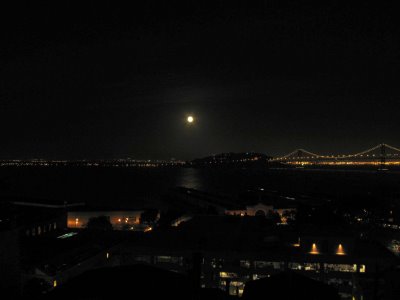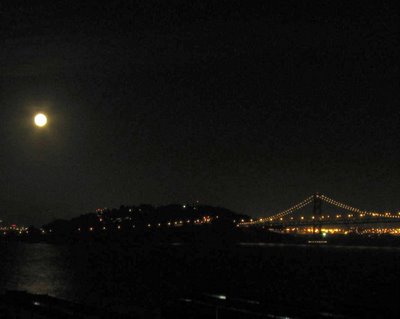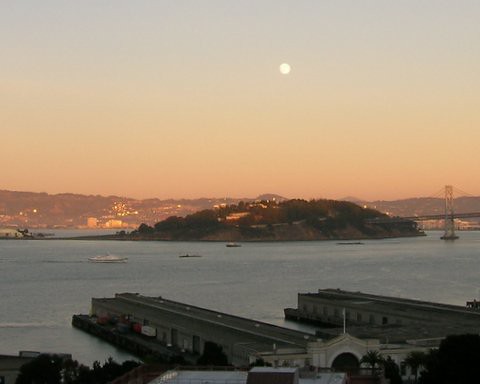BEGIN FIELD TRIP REPORT
Thursday 12 Feb 2009
Up by 3:15A. Super Shuttle pickup at 3:45A for a 6:A departure from SFO.
Arrived O’Hare. Caught GO Shuttle to Fairmont for the 2009 AAAS annual conference, which split meetings between Hyatt Regency (sessions) and Fairmont (plenary talks).
We’ve been attending AAAS meetings during the long Presidents’ Day weekend in February since 2001 when the meeting was held in San Francisco and had dueling plenary talks by Francis Collins (director of the government’s National Human Genome Research Institute) and J Craig Ventner (head of privately-held Celera Genomics) announcing the decoding of the human genome.
Also that year was one of the best (and most beautiful) plenary talks I’ve been to: David Malin‘s overview of astronomy images from the Anglo-Australian Observatory. Beautiful.
We had such an entertaining time that in 2002, when the meeting was in Boston, we went again. And we’ve continued going each year as the meeting moved.
# Boston, Massachusetts, February 2008
# San Francisco, California, February 2007
# St. Louis, Missouri, February 2006
# Washington, D.C., February 2005
# Seattle, Washington, February 2004
# Denver, Colorado, February 2003
# Boston, Massachusetts, February 2002
# San Francisco, California, February 2001
Back in the day when I was writing a monthly surfing-the-web column, I could always depend on the AAAS meeting to give me enough batter to cook up several months of columns.
Arriving at the Fairmont, Chicago, Thursday afternoon, we checked into our room and walked over to the Hyatt to pick up our badges and bags and schedules.
(The AAAS Annual Meeting offers a unique, exciting, interdisciplinary blend of more than 150 symposia, plenary and topical lectures, specialized seminars, poster presentations, and Exhibit Hall.)
From 5-6:30P Thursday, we attended the Canadian reception at the Hyatt and schmoozed and noshed and drank wine, then moved over to the Fairmont for the AAAS opening and plenary talk by James T. McCarthy, President of AAAS, followed by more nosh and wine. Wine at the AAAS function was open bar (and $9/glass of wine!), so the amount poured by the tenders was considerably less than what was poured at the Canadian reception.
Friday 13 Feb 2009
Friday… sessions. His nibs’ background is in experimental high energy particle physics. Mine is in biology with a chemistry minor. When we look at the sessions (15-25 per time slot) and scratch this one and star that one as we decided which of the multitude available we’ll check into and maybe stay with, our choices are amazingly complementary. i.e. He scratches the things I star and vice versa. We do meet up at the noon-time topical lectures sometimes and the evening plenaries, but he’d rather listen to people expound on string theory while I’d rather listen to people talk about the problems of resuscitating dead zones in the Black Sea.
The Friday plenary (Evolutionary biologist Sean B. Carroll on Remarkable Creatures: Epic Adventures in the Search for the Origins of Species ) was held early, (4:30 – 5:30P). Interesting. Carroll talked of Charles Darwin, Alfred Russel Wallace and Henry Walter Bates, who were all under 25 when they went off exploring into the Amazon jungle, the Malay peninsula and on the Beagle and came back and changed biological science. Wallace, Bates and Darwin and their on-going inter-related histories made for an interesting tale.
Luckily for us we went, because some people left after the talk and we shifted over five seats in our row (third row back, stage left, even with the speaker podium) and wound up within feet of the speaker podium with an uninterrupted view.
We sat around, holding onto our super primo seats, waiting for the 6:30-7:30P talk by … Al Gore. We were >< that close to him. The ballroom was packed. The bouncers at the door were checking to make sure all the people filing in to find seats had their conference badges showing. The room kept getting fuller and fuller until it was utterly packed and Gore took the stage, thanking everyone for the welcome, thanking the scientists in the audience (by name) who had helped him further his understanding of climate change, thanking the multitudes who were off in another room listening to his talk because they couldn't be seated in the ballroom.
Interesting to see him do his pitch, which we’ve all heard so much about. I’ve never seen An Inconvenient Truth, but had heard folks tit for tatting about it. Gore had new slides and a revamped talk, updated things to say about climate change. Turns out a slew of scientists at the meeting, including the Prez, who’d given the plenary the night before, had given him long and lengthy explanations about what was going on that he’d used as a basis for parts of his original talk, and this one.
I knew some folks I knew from elsewhere would be having kittens if they were listening to Gore talk, which made it all the more enjoyable.
Walked over, after Gore finished and left the building, to the Elephant & Castle and had a couple Guinness and steaktips in gravy w/ mashed for dinner.
Saturday 14 Feb 2009
Saturday was another full day of sessions.
From 5:-6:30P we went to the AAAS Awards Ceremony and Reception at the Fairmont and enjoyed delish food (lamb riblets, &c.) and wine after. Then on to the 6:30-7:30P plenary address. Planetary scientist Susan W. Kieffer gave Saturday’s address: Celebrating the Earth: Its Past, Our Present, a Future? Kieffer had interesting things to say, but gave her lecture reading from her notes. STOP IT!
One of the things that becomes obvious during AAAS is the difference between having something interesting to say and having an interesting way to say it. Some sessions have talks that are just too mumble mumble boring while others are pepped up and interesting.
Stopped off to see Paul Sereno give his Family Science Day pitch in the exhibit hall on Saturday. He has amazing energy and a way of connecting to young people who come to listen to him talk about hunting down dinosaurs. Compare his stage presence with … well, we won’t go there. Suffice to say that some scientists really really really need media coaching to properly convey the excitement of the stuff they work on.
We returned Saturday night to Elephant & Castle for Valentine’s Day dinner. Ah, the romance.
Sunday 15 Feb 2009
After another full day of sessions, Sunday’s plenary was A Neanderthal Perspective on Human Origins by evolutionary geneticist Svante Pääbo. Interesting guy. Interesting talk.
We had Sunday dinner at the Fairmont because by this time it was snowing a bit and we had no clue which restaurants might be open on Sundays. We’d been stopping off at a coffee/sandwich place for a morning poppyseed bagel (split, toasted, with cream cheese) and coffee on our way over to the Hyatt and discovered Saturday and Sunday that “our” place was closed so we stopped off at a local small market that sold far-too-sweet-plastic-wrapped-coffee-rolls and coffee.
We didn’t want to wander out in the cold and snow Sunday evening and find that the restaurants we might be thinking of going to were closed. Hotel it was. We stopped off in the bar/sushi/casual food venue because we weren’t interested in what a hotel might think was a dining experience. The food arrived tepid. Too long under the heat lamps, perhaps. The service was slow. The food was over priced for what you got. The waitress mis-represented the beer she offered as an alternative after she told us they’d run out of the beer we wanted. (Gee, the beer she offered was $3/bottle more than what we’d ordered and she forgot to mention it?!??! Gee … Odd.)
Other than that …
Monday 16 Feb 2009
Monday was the wrap up of the conference with the last sessions ending at 12:30P. We’d asked for late checkout Sunday evening, and needed the extra time. We caught a cab to the Metra @ Union Station about 1:15. Ate sandwiches at the station while we waited for the express train that zipped us to Naperville in half an hour or so where Mom picked us up with the grandkids in the car — even the teenager, who was off school because it was Presidents’ Day.
Mom is in a bowling league and rather than spend hours there on Tuesday, when her team/league was playing, we went over to the bowling alley Monday evening so she could bowl three games in lieu, with the alley keeping her scores for the league play.
The teenager, his nibs, myself, the five-year-old and the three-year-old bowled in the alley to the right of Mom’s. Our single game took as long as she took to bowl three. The two youngest in our set had to roll the ball with both hands down the alley (bumper guards up of course). We waited patiently each time to see if the ball would even reach the pins. The ball always did, although not at great speed.
The teenager beat me by a point. His nibs came in just a bit behind our scores. Not bad for a couple geezers who hadn’t bowled in forever. (I think my last bowling set was about three decades ago.)
Tuesday 17 Feb 2009
Next day the teenager went to school and the geezers and Mom took the younger ones to the Brookfield Zoo for the day to see dolphins and pennipeds and orangutans and such. Came home in time for Mom to head off to her p/t job.
Wednesday 18 Feb 2009
Wednesday, the teenager stayed home from school to spend some quality time with her gparents. (Permission granted by Mom because the teenager’s grades showed all As and Bs when checked online.)
Thursday 17 Feb 2009
We got up early in order to spend some time with the teenager before she left to catch the school bus at 7:15A. Three and a half hours later, a shuttle picked us up and drove us to O’Hare to catch our plane home.
A fine time was had by me, and I think by all. More complete notes re sessions and plenaries remain to be straightened out.
END FIELD TRIP REPORT



